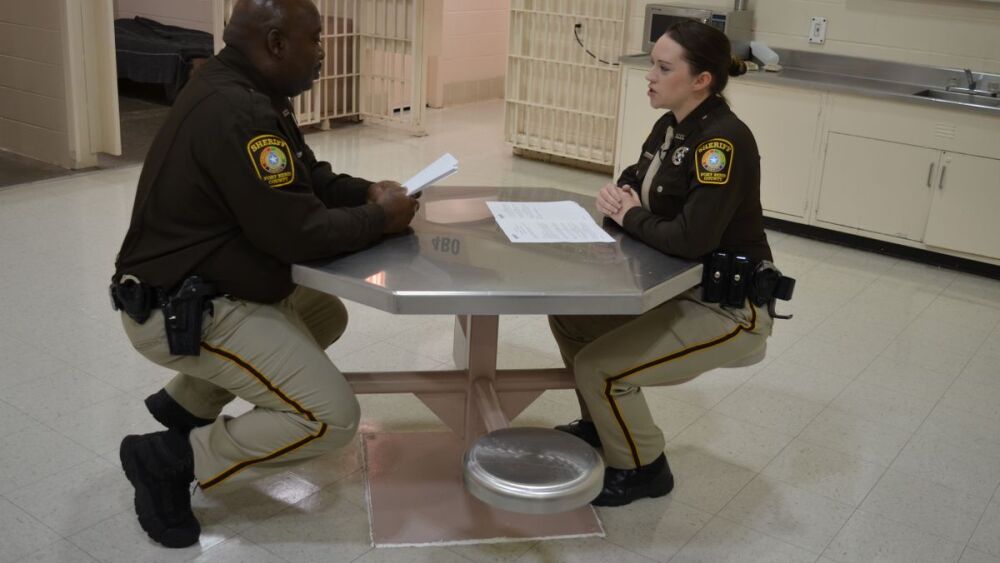Inmate Jones just got some bad news in court. He is normally relatively respectful and cooperative during transports. Today, Jones is looking at five more years in prison. He just yelled at his public defender and told off the judge. The judge gives you the “get him out of my courtroom” nod, and you attempt to escort Jones out to the hallway leading to the court holding cells, about 50 feet away.
Jones isn’t budging, and it’s time to go. You get a good hold of his arm and start to lead him the right way. “Let’s go, Jones.” Jones pulls away from you, toward the exit rather than the hall.
You make quick eye contact with the bailiff to make sure she’s on her radio, calling for backup, and you take Jones down to control him on the floor. Shocked lawyers and a local news reporter give you plenty of elbow room as you work to control Jones’s upper body.
He is in shackles and belly chains, but Jones is motivated and fighting to get loose from your grasp. Backup responds, and you notice one of the bailiffs take control of Jones’ legs. You move to locking up the right arm and another pair of hands grabs the left. Jones isn’t going anywhere, but he didn’t get the memo. He’s still fighting.
Now there are three bailiffs helping you pick Jones up by his arms and legs and carry him toward a waiting transport van. All is well. As the courtroom door closes behind you, you hear the judge call for a recess.
What will you remember when it comes time to write the report?
When you find yourself involved in an incident that takes you by surprise in a correctional facility or during an inmate transport detail, you are responding to a rapidly developing situation. You are making decisions and acting using a mix of instinct, training and skills based on your role as a risk manager. By necessity, our initial actions during these incidents come without too much planning.
How many times, however, have you been finished with an incident report and known that there was information missing? How many times have you wrapped up an incident, whether it’s a use of force, a cell extraction, or a safety placement, and realized that you didn’t really remember all the details you need and therefore can’t put those details in your report.
We all know we can’t write what we didn’t see. However, there needs to be a balance between accurately documenting what happened during an incident and having enough details in a report to confirm that your actions and those of your partners were justified. Too many reports with missing details on a regular basis won’t fly with your supervisor.
MORE THAN FILLING IN THE BLANKS
In most cases, there are overlapping details of what happened among staff members involved in a critical incident. For instance, you may be controlling a combative inmate’s legs while your partner is controlling the right arm, but because the inmate is kicking, your entire focus is on the inmate’s legs and therefore you cannot accurately document what your partner was doing. Your partner will have her piece of the story and limited detail on your role.
We have a natural tendency to fill in the blanks when we know part of the story, using logic based on a sequence of events to tell the whole story. But if you write something that isn’t accurate, you have now written something that is untrue. When you write something that is untrue, you end up in the commander’s office fighting for your career. This is where paying closer attention to the incidents you find yourself in will benefit you.
When do we start writing our reports? Is it right after an incident? Does your facility mandate that you finish your incident reports prior to going off-shift? The question should be, when do we start composing our reports?
From the moment you become engaged in an incident, you should be composing your report. For example, when you engage in a use of force, you should be paying attention to what is going on and to the details of who has which body part of a combative inmate under control. This may seem counter-intuitive because we do need to focus on the task that we are handling in any incident, but don’t undersell your abilities. Regardless, you need to know enough to justify your physical response to an incident.
The mindful response to a critical incident
Maybe not on day one, but once you have been through several incidents, especially several critical incidents in your correctional facility, you will know what you need to do. And within a team that you have worked with long enough, everyone will know their role.
Once you know what to do, you will be able to pay closer attention to what’s going on during a critical incident and take long enough pauses to mentally note the time, who has what part of a combative inmate’s body under control, what the inmate is saying and how the inmate is reacting to directions or commands.
During most incidents, there will be short moments for staff to communicate with each other or for the supervisor to adjust people’s positions to more safely achieve control of an inmate. Use those moments to pay attention to what’s going on outside your portion of the incident. There may be a moment where you have full control of a task or one part of the combative inmate’s body. Take that moment to look at your watch, note the time, listen to what is being said. Observe if the inmate is still fighting at some level.
When you get to the point where you can become an observer of and a participant in an incident at the same time, two things will happen. The first is you will have a much better idea of what’s going on and you will recall the incident in finer detail. This leads to more accurate reports with more details than you would have if you were acting solely on muscle memory and training.
The second important benefit is that it removes you slightly from the emotions you may be experiencing related to the incident. As you focus more on observing, your physical actions become more mechanical and controlled, allowing you to respond with just the right amount of force to stop a threat and to make small adjustments for the safety of your partners and the inmate.
The ability to observe an incident while being involved in it doesn’t come naturally and will take some practice. Focus on your safety first but increase your awareness and observation as your tactical skills improve. The more you can include observation into your tactics, the more details you will be able to recall when you sit down and write your incident reports.











